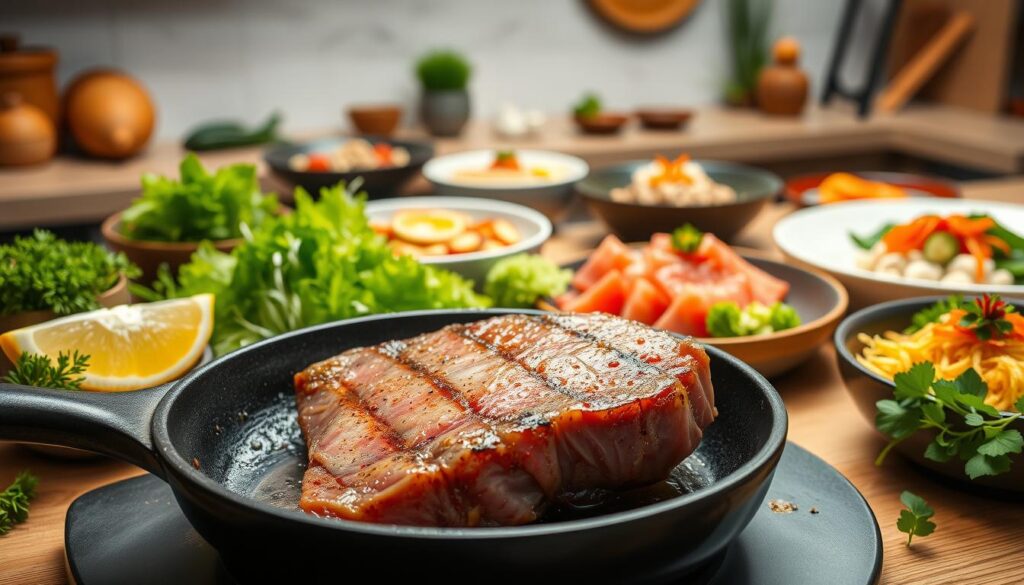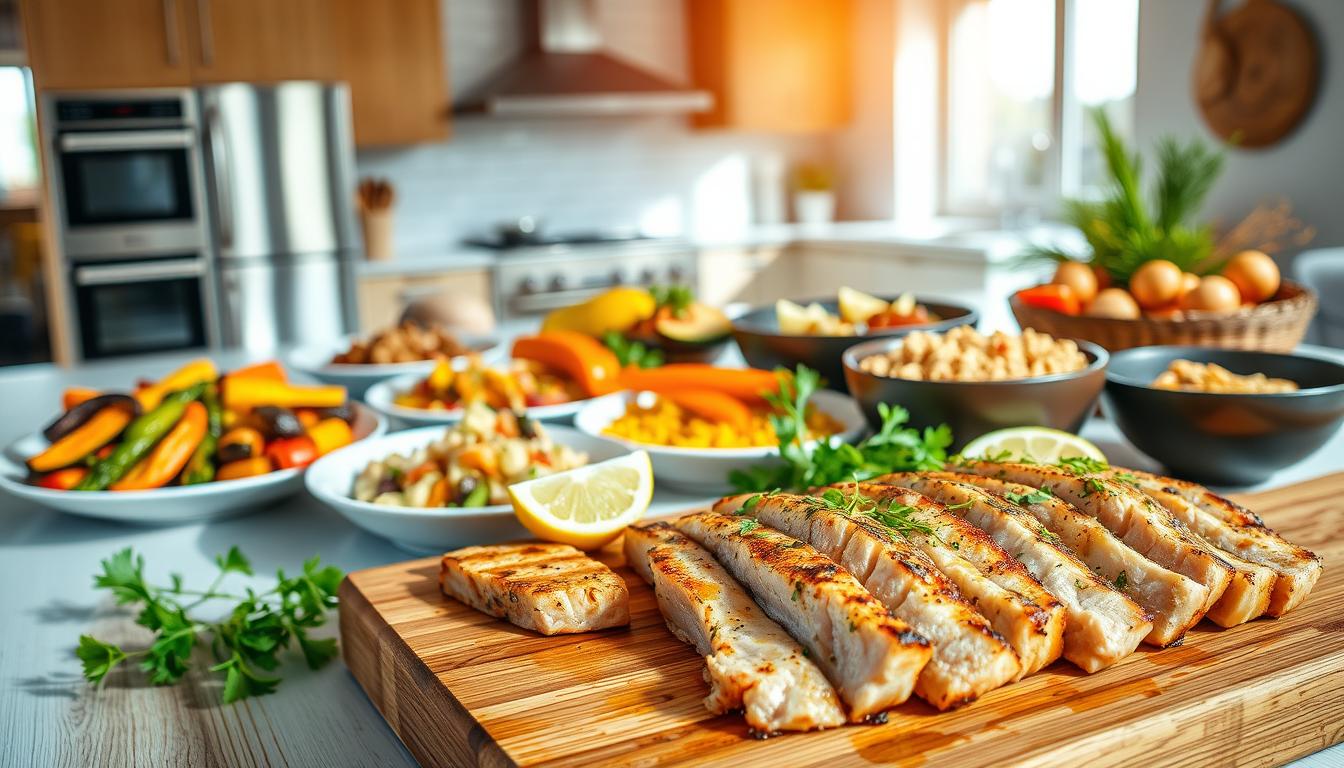Have you ever spent time preparing a dish, only to end up with dry, tough results? Many home cooks face this challenge, especially when working with Bonito Tuna Fish Recipes. This versatile ingredient has a unique flavor that can elevate any meal, but it requires careful handling to shine1.
Bonito is prized for its rich umami taste, making it a favorite in many cuisines. However, improper storage or overcooking can ruin its texture and flavor. For example, using the wrong temperature or leaving it out too long can lead to disappointing results1.
In this guide, you’ll learn how to avoid common mistakes like overcooking, improper seasoning, and mishandling. We’ll also share tips on innovative pairings, storage, and cooking techniques to help you achieve consistently delicious results. Whether you’re grilling or preparing a sauce, these insights will ensure your dish turns out perfectly every time.
Key Takeaways
- Proper handling is essential to maintain bonito’s unique flavor and texture.
- Overcooking can lead to dry, tough results, so timing is crucial.
- Innovative pairings with ingredients like olive oil and ginger can enhance the dish.
- Storage techniques play a key role in preserving freshness.
- Following step-by-step instructions ensures consistent success.
Understanding Bonito Tuna: A Versatile Fish
From Japanese dashi broth to Mediterranean grills, Bonito Tuna Fish Recipes has a global culinary presence. This versatile ingredient is not only rich in flavor but also offers numerous health benefits. Let’s explore its history, classification, and why it’s a sustainable choice for your kitchen.
History and Classification of Bonito Tuna
Bonito belongs to the Scombridae family, which includes other well-known species like bluefin and yellowfin. Unlike its glamorous cousins, bonito is often overlooked but plays a crucial role in traditional cuisines. For example, it’s a key ingredient in Japanese dashi broth, made from dried and fermented bonito flakes2.
Its classification as a smaller, faster-growing fish makes it a more sustainable option compared to overfished species like bluefin. This makes bonito a responsible choice for environmentally conscious consumers2.
Nutritional Benefits and Sustainability
Bonito is packed with protein and omega-3 fatty acids, essential for heart health and brain function. A single serving provides a significant portion of your daily nutritional needs, making it a healthy addition to any diet3.
Its sustainability is another major advantage. Bonito’s lower commercial demand helps reduce overfishing pressures, ensuring its availability for future generations2.
| Nutrient | Bonito Tuna | Bluefin Tuna |
|---|---|---|
| Protein (per 100g) | 25g | 23g |
| Omega-3 Fatty Acids | 1.5g | 1.2g |
| Sustainability | High | Low |
Whether you’re grilling a steak or preparing a light salad, bonito’s robust flavor and nutritional profile make it a standout choice. Proper handling and cooking techniques ensure you get the most out of this versatile fish.
Bonito Tuna Fish Recipes: Avoiding Common Mistakes
Mastering bonito dishes requires attention to detail and avoiding common pitfalls. From handling to cooking, each step plays a crucial role in preserving its unique flavor and texture. Let’s dive into practical tips to ensure your dish turns out perfectly every time.

Handling and Storage to Keep the Fish Fresh
Proper handling starts the moment you bring the catch home. Immediate chilling and icing are essential to maintain freshness. This prevents bacterial growth and preserves the delicate texture1.
Store it in a sealed container or wrap it tightly in plastic Bonito Tuna Fish Recipes. Keep it at a consistent temperature, ideally below 40°F. This ensures the fish stays fresh until you’re ready to cook1.
Cooking Techniques to Prevent Dryness and Toughness
High-heat methods like grilling or pan-searing work best. These techniques lock in moisture while creating a flavorful crust. Aim for an internal temperature of 125°F for medium-rare, ensuring the center remains tender4.
Use quality olive oil to prevent sticking and enhance flavor. Season with salt and pepper, and consider adding ginger or soy for an extra kick. Timing is crucial—cook for just the right number of minutes to avoid dryness4.
Tips for Preventing Overcooking and Maintaining Flavor
Precision is key when cooking bonito. Use a timer to monitor cooking time, and remove it from heat as soon as it reaches the desired doneness. Let it rest for a few minutes before serving to allow the juices to redistribute1.
Pair it with sides like a fresh salad or a zesty poke bowl. A squeeze of lemon or lime can brighten the dish and enhance its natural flavors. These small touches make a big difference in the final result4.
Exploring Flavorful Techniques and Pairings
Unlock the full potential of your culinary skills with bold flavor pairings. Whether you’re preparing a quick weeknight meal or an elaborate dinner, the right techniques and ingredients can make all the difference. Let’s dive into creative ways to enhance your dishes.

Innovative Sauces and Marinades for Enhanced Taste
Elevate your dishes with sauces and marinades that bring out the best in your ingredients. A roasted red pepper sauce adds a smoky sweetness, while a citrus marinade with lemon and lime brightens the flavor profile5.
For a bold twist, try a soy-based glaze with ginger and garlic. This combination not only enhances the natural umami but also adds depth to the dish5. Pair it with a sprinkle of sesame seeds for a finishing touch.
“The right sauce can transform a simple dish into a culinary masterpiece.”
Grilling Methods and Complementary Side Salads
Grilling is a fantastic way to achieve a crispy exterior while keeping the inside moist. Preheat your grill to medium-high heat and brush the grates with olive oil to prevent sticking6. Cook for 2-3 minutes per side for a perfect sear.
Complement your grilled dish with a fresh side salad. Combine mixed greens, kalamata olives, and sun-dried tomatoes for a Mediterranean-inspired option6. A light vinaigrette with Dijon mustard ties everything together.
| Ingredient | Quantity | Purpose |
|---|---|---|
| Olive Oil | 2 tbsp | Prevents sticking, enhances flavor |
| Soy Sauce | 1/4 cup | Adds umami and depth |
| Lemon Juice | 1 tbsp | Brightens the dish |
Experiment with these techniques and pairings to create dishes that are both flavorful and visually appealing. With the right balance of ingredients and methods, you’ll impress every time.
Conclusion
Mastering the art of cooking with this versatile ingredient requires attention to detail and a few extra minutes of preparation. Proper handling, storage, and cooking techniques ensure the dish retains its unique flavor and texture7. By carefully selecting seasonings and marinades, you can elevate the taste and create a well-rounded meal.
Innovative methods like grilling and pairing with fresh salads add depth to your culinary creations. Experimenting with sauces and side dishes can transform a simple dish into something extraordinary8. These techniques not only enhance the flavor but also make the process enjoyable.
Choosing sustainable ingredients like this one supports both your health and the environment. Its rich nutritional profile, including protein and omega-3s, makes it a smart addition to your diet7. With these tips, you can confidently create dishes that impress every time.
Revisit the detailed guide to refine your skills and avoid common mistakes. Your kitchen adventures are sure to yield delicious results with these insights.

